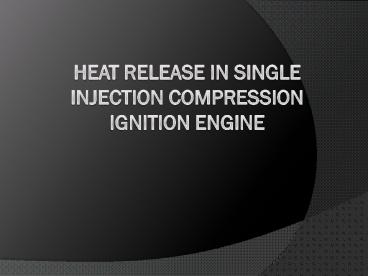HEAT RELEASE in single injection compression ignition engine - PowerPoint PPT Presentation
Title:
HEAT RELEASE in single injection compression ignition engine
Description:
HEAT RELEASE: Rate at which the chemical energy of the fuel is released by the combustion process. It can be calculated from cylinder pressure versus crank angle data ... – PowerPoint PPT presentation
Number of Views:104
Avg rating:3.0/5.0
Title: HEAT RELEASE in single injection compression ignition engine
1
HEAT RELEASE in single injection compression
ignition engine
2
HEAT RELEASE
- Rate at which the chemical energy of the fuel is
released by the combustion process. - It can be calculated from cylinder pressure
versus crank angle data, as the energy release
required to create the measured pressure, using
the known techniques.
3
Spray structure
- The fuel is introduced into the combustion
chamber thro one or more nozzles or orifices with
large pressure difference between fuel supply
line and cylinder. - Std diesel injectors operate with fuel injection
pressures between 200 and 1700 atm
4
Heat release rate in diesel engine systems
- The engine taken into study had central fuel
injection through a four-hole nozzle into a
disc-shaped bowl-in-position combustion chamber. - There is a delay of 9o between the start of
injection and start of combustions.
5
(No Transcript)
6
Combustion stages
- The combustions process proceeds in three
distinguishable stages. - 1st stage -Rate of burning is generally very high
and lasts only for few crank angle degrees. It
corresponds to the period of rapid cylinder
pressure rise. - 2nd stage-Corresponds to a period of gradually
decreasing heat-release rate. This is the main
heat-release period and lasts about 40o.
Normally about 80 of the total fuel energy is
released in the first two stages. - 3rd Stage corresponds to the tail of the
heat-release diagram in which a small but
distinguishable rate of heat release persists
throughout much of the expansion stroke. The
heat release during this period usually amounts
to about 20 of the total fuel energy.
7
Observations from energy release
- The total burning period is much longer than the
injection period. - The magnitude of the initial peak of the
burning-rate diagram depends on the ignition
delay period, being higher for longer delays.
8
(No Transcript)
9
Rate of heat release vs crank angle
- The period between the start of fuel injection
into the combustion chamber and the start of
combustion is the ignition delay. - The premixed or rapid combustion phase is the
phase where the combustion of the fuel which has
mixed with air to within the flammability limits
during the ignition delay period occurs rapidly
in a few crank angle degree.
10
- Once the fuel and the air which premixed during
the ignition delay have been consumed, the
burning rate is controlled by the rate at which
mixture becomes available for burning. - The late combustion is where the heat release
continues at a lower rate well into the expansion
stroke
11
- At time of injection the air in the cylinder has
a pressure of 50 to 100 atm, and temperature
about 1000 K - The initial jet velocity is greater than 100 m/s.
- The outer surface of the jet breaks up into drops
of order 10µm. - The major region of the spray is a substantial
vapor cloud around this narrow core which
contains liquid fuel.
12
Spray and flame structure
13
Thank you
14
? Any question???































